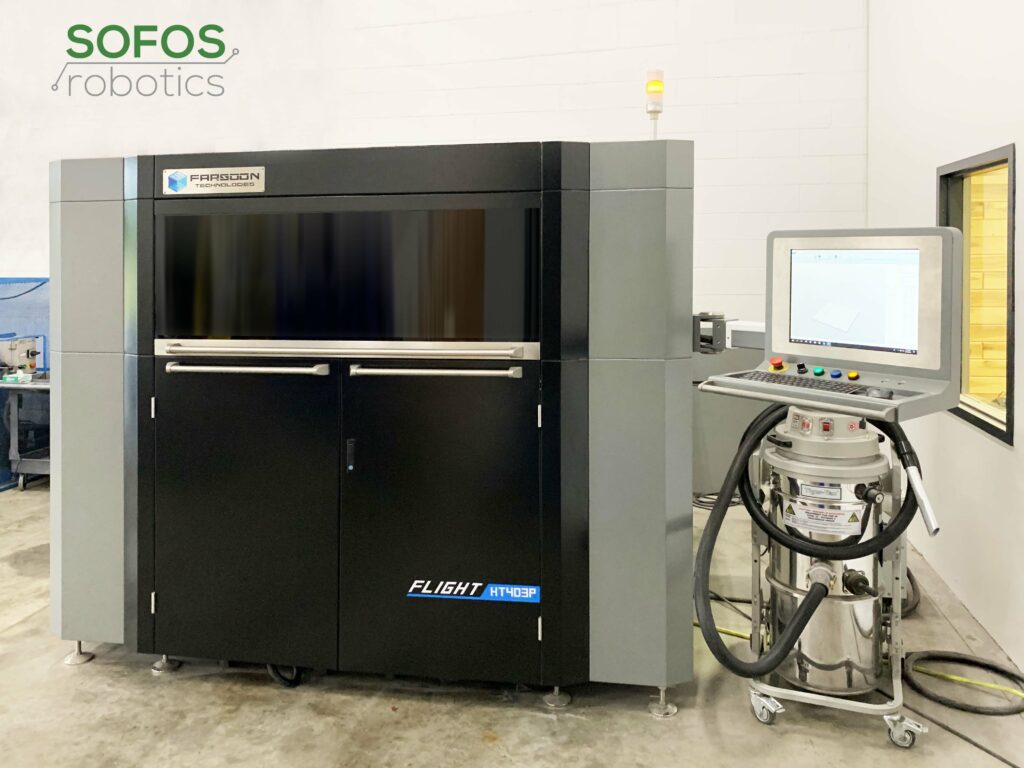Focus on application-specific materials
Farsoon Technologies first introduced Flight® Technology or Fiber Light® Technology in 2019 offering industry-leading production rates with plastic laser powder bed fusion. In 2021 the Dual-Laser configuration of the Flight® 403P system was announced with even higher productivity. Since then, many of Farsoon’s customers take advantage of the powerful fiber lasers for volume production of high quality, end-use parts. Featuring an open material platform, the Flight® HT403P system at Sofos Robotics Co. (referred to as Sofos Robotics) enables a number of industrial projects from prototyping to series production using a diverse range of application-specific, engineering materials. Jason Rodriguez, marketing specialist from Farsoon Americas Corp interviewed the President of Sofos Robotics, John Huster, to find out how they use Flight® Technology. Here’s what we learned.
Rodriguez: Can you share the history of Additive Manufacturing at Sofos?
Huster: Sofos Robotics started as an automation and robotic integration service provider to maximize efficiency in industrial manufacturing. We got into additive manufacturing to improve the components that we needed for automation cells such as custom brackets and mounting plates, part nests and gripper fingers.
We started with a couple of FDM machines and began printing components for ourselves and a handful of clients. In the beginning we were focused on prototyping and small production runs. As our business grew, we got to the point where we knew FDM wasn’t going to be able to produce the quantity of parts we needed fast enough. We started looking at other technologies and decided on the Farsoon Flight® machine due to its speed and flexibility. We see additive manufacturing as a technology with great potential. We plan to continue growing our business by finding new markets and helping our clients solve problems.

Rodriguez: Why did Sofos Robotics choose Farsoon and Flight®Technology?
Huster: We started in additive technology, like many others, using FDM 3D machines. We had a couple of customers who we were prototyping parts for, and they started asking about our production capabilities. We saw an opportunity to grow and started looking into different 3D Printing Technologies. We went with the Farsoon Flight® HT403P due to its big build volume, incredibly fast speeds, and open material / parameter platform. We also liked that Farsoon had fewer consumables and more cost-effective service packages than some of the other machines we were looking at.
Rodriguez: Can you share a specific application story with additive manufacturing at Sofos?
Huster: One of the clients has us running production of a custom ESD safe nylon guard. For this part, because of the environment, we had to use an ESD safe material. Prior to using additive manufacturing, the guards were made of stainless steel and the 2 halves were welded together. The clients wanted a new single piece solution to reduce the failure rate. Using the Farsoon Flight® machine along with an ESD safe nylon material from BASF, we have been able to provide them with a structurally-integrated solution at a lower cost and faster turnaround. Before we had the Farsoon machine it would take 1 of our FDM machines 12 hours to print 1 guard. We are now able to print 12 guards plus a full set of accompanying brackets in the same amount of time.
Rodriguez: We know many of the projects at Sofos are using specific engineering materials. How is your experience with Farsoon’s open material / parameter platform?
Huster: This was one of the key selling points when we were looking at what machine to purchase. We really liked the idea of an open material platform and being able to shop materials from different manufacturers to find the right solutions for our customers. We get a variety of requests from customers and being able to use material from different vendors has benefitted us many times.
The open parameter platform is great! It allows us to quickly dial in a new material in 1-2 builds. It’s nice to be able to control so many parameters such as: operating temperature, laser scan power, scanning distance, etc. The open platform allows us to assign different parameters to each part in the build and test multiple combinations to find the perfect recipe. We can also add or take out parts while the machine is printing. All of this is very helpful when we try a new material for the first time.
Rodriguez: We know Sofos has successfully tested a few BASF materials. Can you share with us more testing results, and if any industry targeted?
Huster: We have had a great experience with BASF. They have a wide selection of materials and corresponding part parameters. We currently use their PA11 ESD, TPU and PA6 Mineral filled materials. The materials have proven themselves in testing and in the field and we look forward to using more of their products in the future.
Some projects we are working on with the TPU are custom suctions cups and custom pendant controller guards. We have a lot of fun with this material and look forward to more applications with it.
Rodriguez: Can you share your experience working with Farsoon and Flight® 403P machine?
Huster: We’ve had a great experience working with Farsoon, they’ve been very helpful throughout the whole process and continue to show us support with any questions that we have.
Remember, you can post job opportunities in the AM Industry on 3D ADEPT Media free of charge or look for a job via our job board. Make sure to follow us on our social networks and subscribe to our weekly newsletter : Facebook, Twitter, LinkedIn & Instagram ! If you want to be featured in the next issue of our digital magazine or if you hear a story that needs to be heard, make sure to send it to contact@3dadept.com

